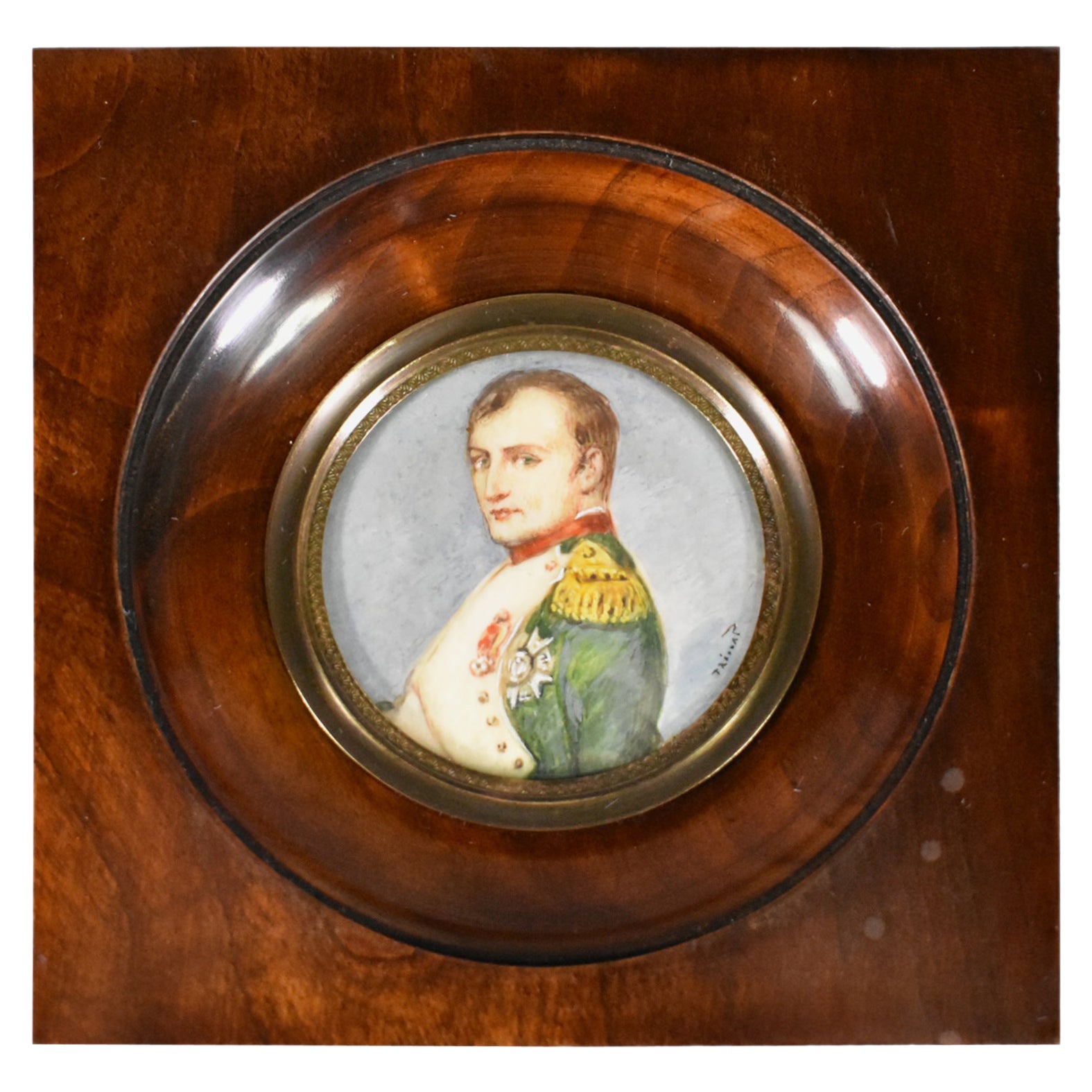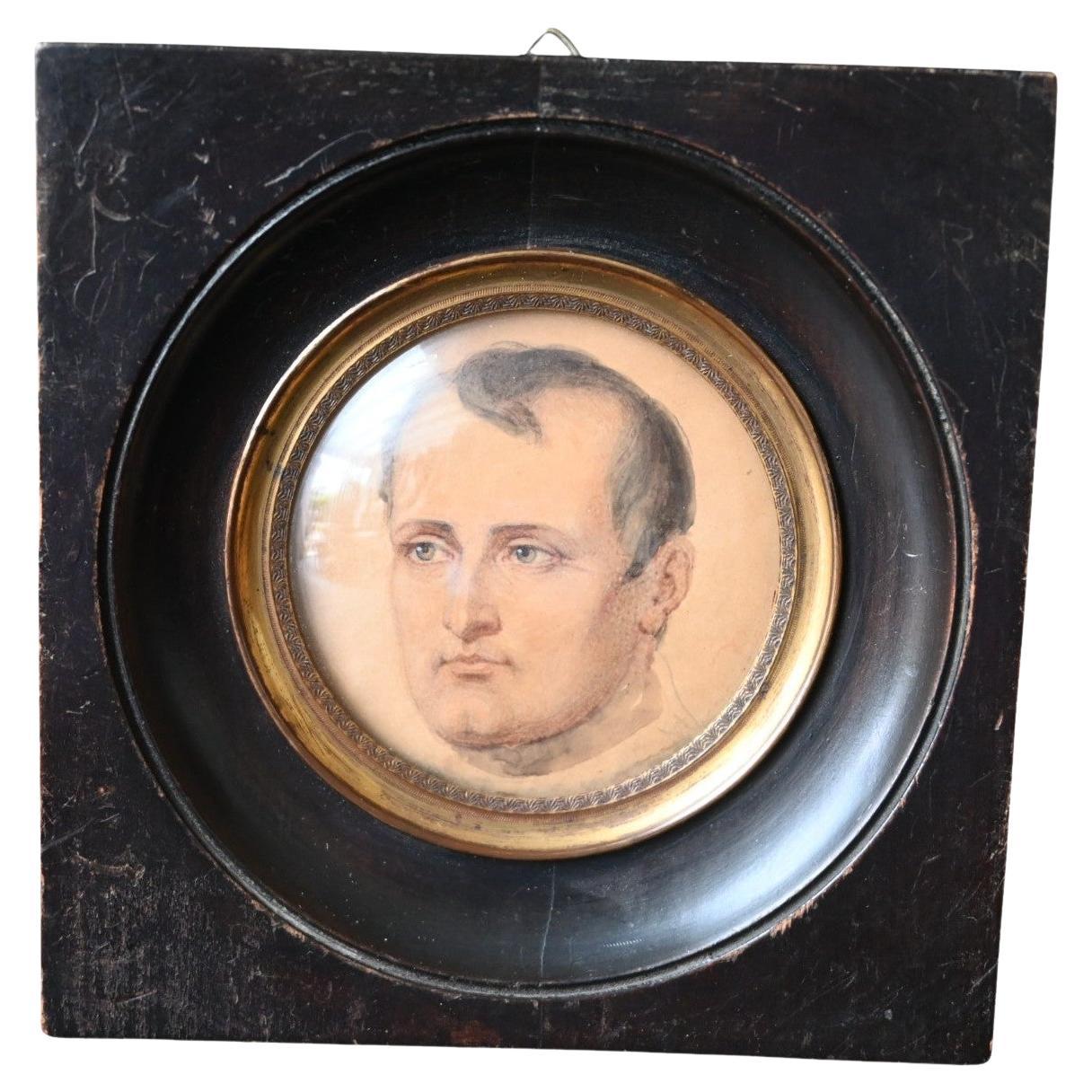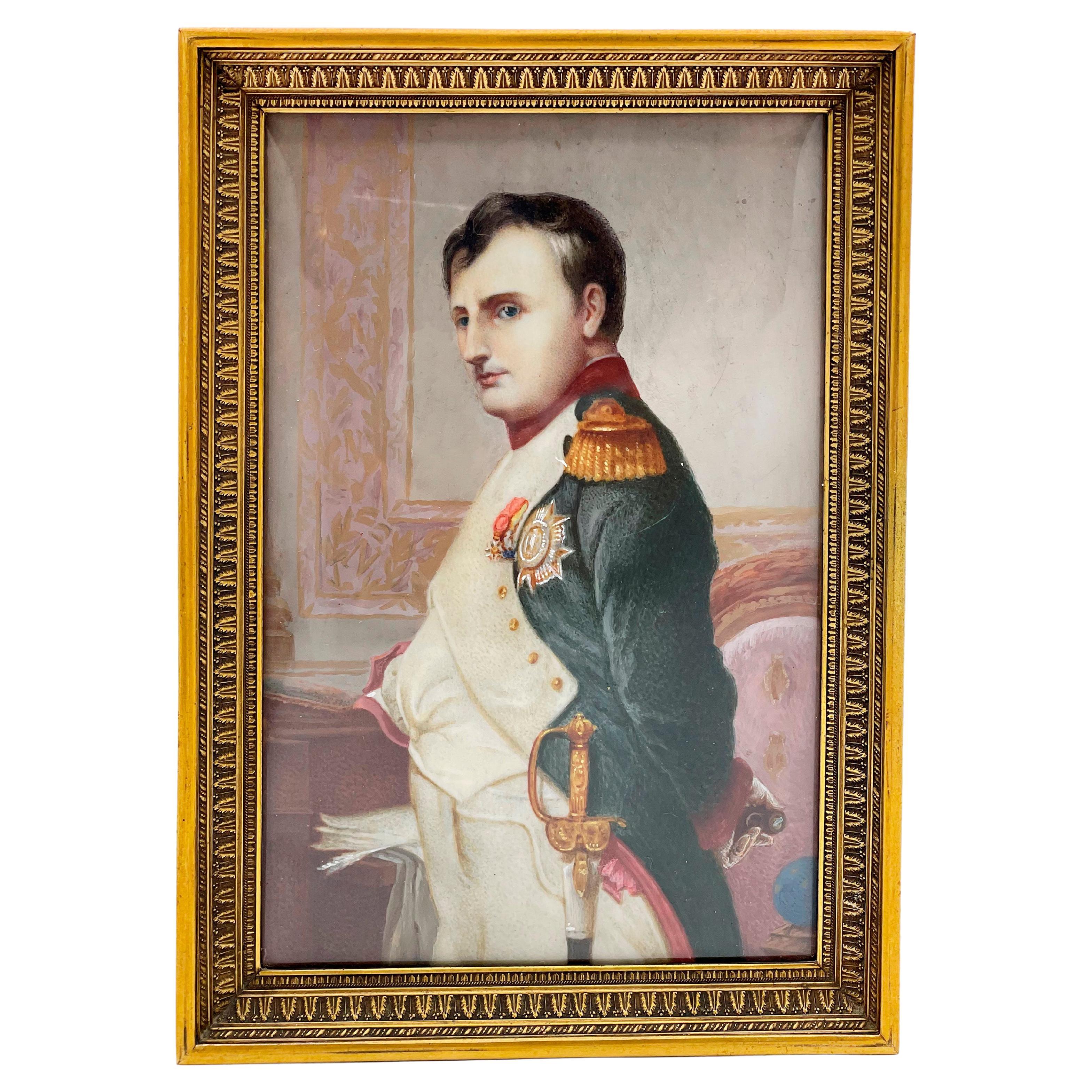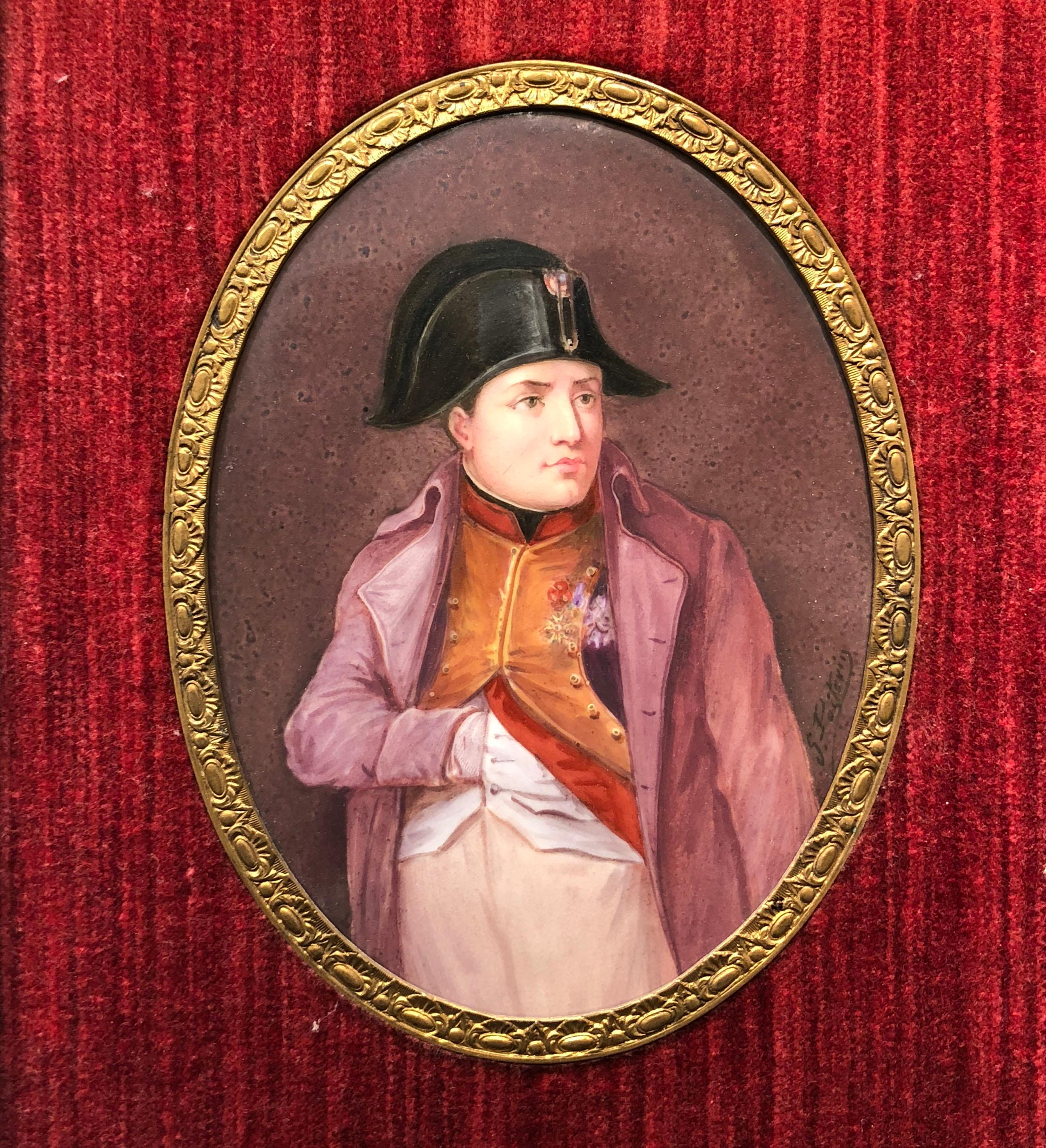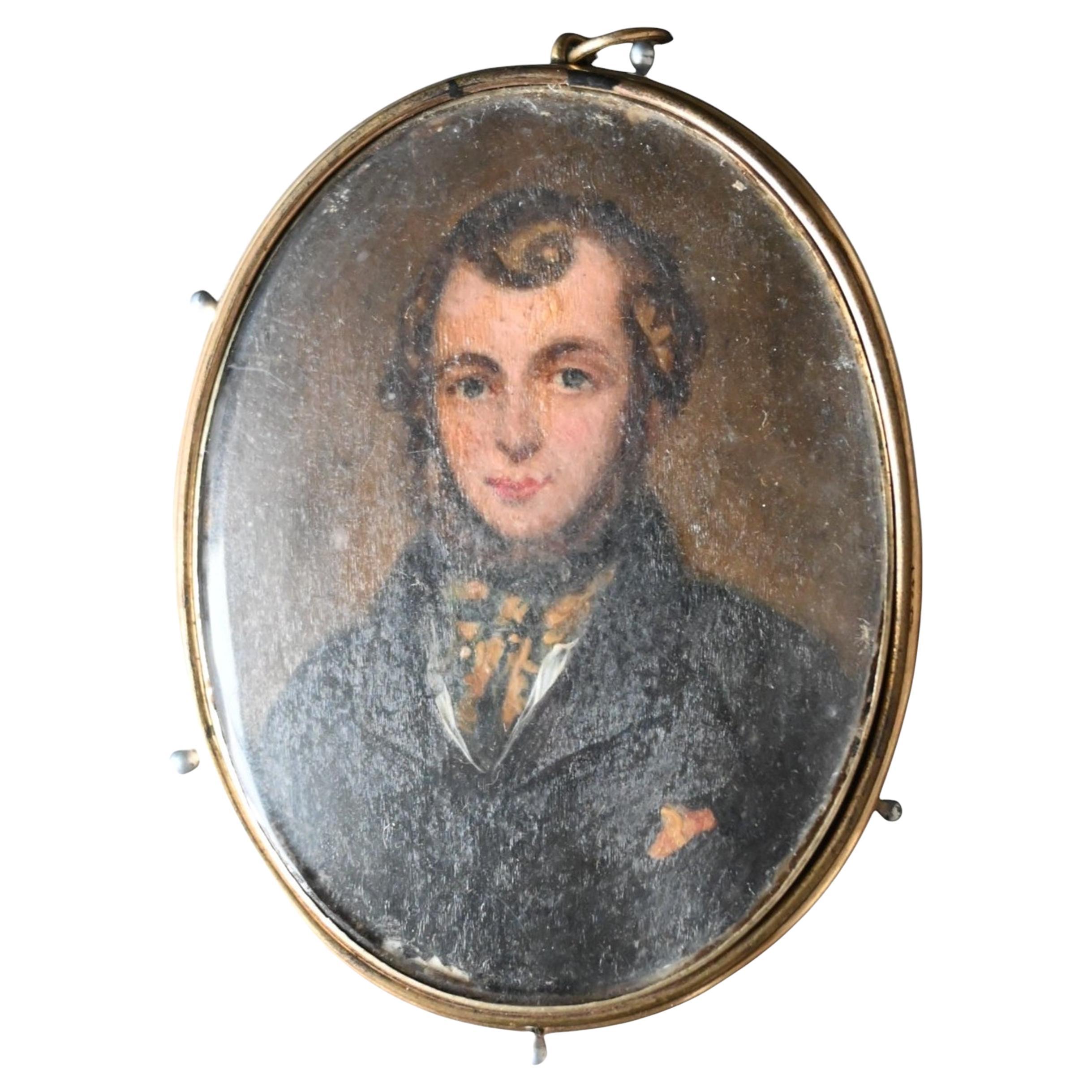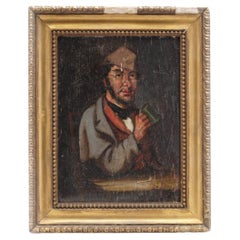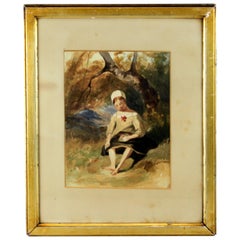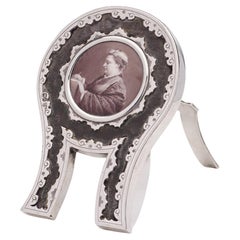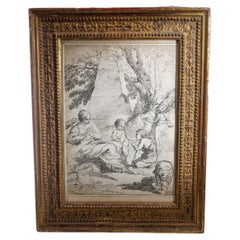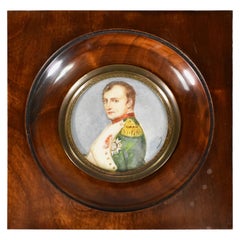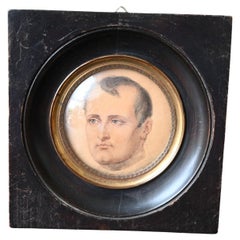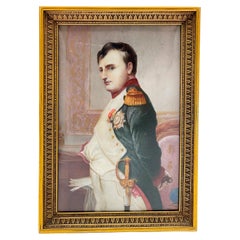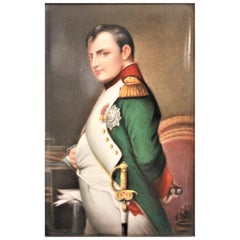Items Similar to 19th-century hand-painted watercolour miniature portrait of Napoleon I
Video Loading
Want more images or videos?
Request additional images or videos from the seller
1 of 8
19th-century hand-painted watercolour miniature portrait of Napoleon I
$1,231.89
£895
€1,049.08
CA$1,681.77
A$1,870.90
CHF 980.75
MX$22,861.91
NOK 12,488.60
SEK 11,756.29
DKK 7,831.02
Shipping
Retrieving quote...The 1stDibs Promise:
Authenticity Guarantee,
Money-Back Guarantee,
24-Hour Cancellation
About the Item
Antique 19th-century mahogany wood-framed hand-painted watercolour miniature portrait of Napoleon I.
The miniature depicts a Napoleon I portrait turning his face to the right.
The back has not been opened to inspect.
The signature is on the lower right-hand side.
Height: 11.2 cm
Width: 10.4 cm
Depth: 2 cm
Condition: The painting is pre-owned with minor signs of usage, age-related wear, and good overall condition.
The history of Napoleon I
Napoleon Bonaparte, commonly known as Napoleon I, was a military and political leader who rose to prominence during the French Revolution in the late 18th century. Born in Corsica in 1769, he quickly climbed the ranks of the French military, displaying exceptional strategic acumen and leadership skills. In 1799, Napoleon staged a coup d'état, overthrowing the French government and establishing himself as First Consul. He later crowned himself Emperor of the French in 1804. Renowned for his military genius, Napoleon expanded the French Empire across much of Europe through a series of brilliant and daring military campaigns, collectively known as the Napoleonic Wars. His legal reforms, known as the Napoleonic Code, had a lasting impact on modern legal systems. However, his ambitious expansionist policies eventually led to his downfall. Defeated at the Battle of Waterloo in 1815, Napoleon was exiled to the remote island of Saint Helena, where he died in 1821. Despite his ultimate defeat, Napoleon I remains a complex and influential figure in world history, leaving a lasting legacy that continues to be studied and debated.
About the Seller
4.7
Vetted Professional Seller
Every seller passes strict standards for authenticity and reliability
Established in 2015
1stDibs seller since 2017
105 sales on 1stDibs
Typical response time: 18 hours
- ShippingRetrieving quote...Shipping from: Braintree, United Kingdom
- Return Policy
Authenticity Guarantee
In the unlikely event there’s an issue with an item’s authenticity, contact us within 1 year for a full refund. DetailsMoney-Back Guarantee
If your item is not as described, is damaged in transit, or does not arrive, contact us within 7 days for a full refund. Details24-Hour Cancellation
You have a 24-hour grace period in which to reconsider your purchase, with no questions asked.Vetted Professional Sellers
Our world-class sellers must adhere to strict standards for service and quality, maintaining the integrity of our listings.Price-Match Guarantee
If you find that a seller listed the same item for a lower price elsewhere, we’ll match it.Trusted Global Delivery
Our best-in-class carrier network provides specialized shipping options worldwide, including custom delivery.More From This Seller
View All19th-century oil on wood panel painting featuring a man drinking in a tavern
Located in Braintree, GB
19th-century oil on wood panel painting featuring a man in a tavern.
This oil painting, delicately rendered on a wooden panel, captures a captivating scene from the 19th century.
Th...
Category
Antique Mid-19th Century European Paintings
Materials
Wood
Antique Watercolour Painting "Girl in Forest", circa 1850s
Located in Braintree, GB
Title: Girl in forest
Artist: Unknown
Medium: Watercolor
Painted in circa 1850.
Dimensions:
Image size: 21.3 × 16.3 cm
Total dimensions: 36 × 29.5 × 1.7 cm
Approximate we...
Category
Antique 1850s Paintings
Materials
Hardwood
Victorian silver miniature Picture Frame
By Louis Dee
Located in Braintree, GB
Antique Victorian silver miniature Picture Frame, with applied sepia enamel portrait of a lady writing at her desk, the pierced frame with leatherette background.
Hinged easel stand....
Category
Antique 1870s British Late Victorian Picture Frames
Materials
Silver
Francesco Bartolozzi RA, 1728–1815, after an original painting of Pietro Testa
Located in Braintree, GB
Francesco Bartolozzi RA, 1728–1815, after an original painting of Pietro Testa
Etching is depicting the holy Family, with Shepherd and Baby Jesus.
Made ...
Category
Antique 17th Century European Paintings
Materials
Paper
Antique Portrait of Anne of Denmark, attributed to a Follower of Paul van Somer
Located in Braintree, GB
This exquisite portrait, rendered in oil on copper, presents a three-quarter-length depiction of Anne of Denmark (1574-1619), the esteemed queen consort of King James VI and I. Anne,...
Category
Antique Early 17th Century European Paintings
Materials
Copper
H. Stannava 19th Century Oil Painting of canvas with rural scene
Located in Braintree, GB
This 19th-century oil painting on canvas depicts the idyllic rural life of villagers. The scene captures a man and a woman seated in a carriage drawn by two horses. One horse appears...
Category
Antique 1860s European Paintings
Materials
Canvas
You May Also Like
Miniature Portrait Painting of Napoleon Signed by Prévost
By Prevost
Located in SAINTE-COLOMBE, FR
Miniature Portrait Painting of Napoleon signed by Prévost from the nineteenth century.
The frame is in solid mahogany and is dished and...
Category
Antique 19th Century French Empire Paintings
Materials
Brass
Fine Early 19th-Century Portrait Miniature of Napoleon Bonaparte
Located in Bilzen, BE
Fine Early 19th-Century Portrait Miniature of Napoleon Bonaparte
Watercolor on Paper Original Period Frame
An evocative and finely executed early 19th-century portrait miniature de...
Category
Antique Early 19th Century French Empire Historical Memorabilia
Materials
Wood, Paper
Oil Painting Portrait Miniature: Napoleon Bonaparte, Full Military Dress
Located in Autonomous City Buenos Aires, CABA
Antique Oil Painting French Portrait Miniature: Napoleon Bonaparte, Full Military Dress
France, Mid-19th Century
Measures:
13 centimeters ...
Category
Antique Mid-19th Century French Neoclassical Paintings
Materials
Wood
Antique Hand-Painted Porcelain Framed Plaque or Panel of Napoleon Bonaparte
Located in Hamilton, Ontario
This well executed hand painted porcelain panel is unsigned, but presumed to have been done in France in approximately 1850 in a Renaissance style. The panel is an iconic depiction o...
Category
Antique Mid-19th Century French Renaissance Paintings
Materials
Porcelain, Wood
Napoleon
By Manufacture Nationale de Sèvres
Located in Missouri, MO
Sevres 19th C.
Original Hand Painted Porcelain
Signed "G Poitevin"
approx 9 x 5 inches/15 x 12 framed
The vast and diverse production of the Sèvres factory in the nineteenth century resists easy characterization, and its history during this period reflects many of the changes affecting French society in the years between 1800 and 1900. Among the remarkable accomplishments of the factory was the ability to stay continuously in the forefront of European ceramic production despite the myriad changes in technology, taste, and patronage that occurred during this tumultuous century.
The factory, which had been founded in the town of Vincennes in 1740 and then reestablished in larger quarters at Sèvres in 1756, became the preeminent porcelain manufacturer in Europe in the second half of the eighteenth century. Louis XV had been an early investor in the fledgling ceramic enterprise and became its sole owner in 1759. However, due to the upheavals of the French Revolution, its financial position at the beginning of the nineteenth century was extremely precarious. No longer a royal enterprise, the factory also had lost much of its clientele, and its funding reflected the ruinous state of the French economy.
However, the appointment in 1800 of Alexandre Brongniart (1770–1847) as the administrator of the factory marked a profound shift in its fortunes. Trained as both an engineer and a scientist, Brongniart was both brilliant and immensely capable, and he brought all of his prodigious talents to the running of the troubled porcelain factory. He directed the Sèvres factory as administrator until his death in 1847, and during those five decades influenced every aspect of its organization and production. Much of the factory’s old, undecorated stock was immediately sold off, and new forms—largely in the fashionable, more severe Neoclassical style—were designed to replace out-of-date models. The composition for hard-paste porcelain was improved, and the production of soft paste, for which the factory had been famous in the previous century, was abandoned in 1804. New enamels colors were devised, and Brongniart oversaw the development of a new type of kiln that was both more efficient and cost-effective.
Much of the factory’s output during Brongniart’s first decade reflected the prevailing Empire taste, which favored extensive gilding, rich border designs, and elaborate figural scenes (56.29.1–.8). Backgrounds simulating marble or a variety of hardstones were employed with greater frequency (1987.224); the new range of enamel colors developed under Brongniart made it easier to achieve these imitation surfaces, and it is thought that his interest in mineralogy provided the impetus for this type of decoration.
For objects produced in sets, such as dinner, tea, and coffee services, and even garnitures of vases, Brongniart preferred decorative schemes that linked the objects in terms of subject matter as well as stylistically. Dinner services were given coherence by the use of an overall theme, in addition to shared border patterns and ground colors. One of the best examples of this can be found in the “Service des Départements,” which was conceived by Brongniart in 1824 (2002.57). Each of the plates in the service was decorated with a famous topographical view of the département (administrative unit) of France that it represented, and its border was painted with small cameo portraits of figures from the region, as well as symbols of the major arts, industries, and products of the area. This same type of thematic unity is found on a coffee service produced in 1836 (1986.281.1ab–4). All of the pieces of the service are decorated with scenes depicting the cultivation of cacao, from which chocolate is made, or various stages in the preparation of chocolate as a beverage. The compositions were conceived and executed by Jean Charles Develly, a painter at Sèvres who was responsible for many of the most ambitious dinner services produced at the factory during Brongniart’s tenure.
The range of objects produced in the first half of the nineteenth century was enormous, as were the types of decoration that they employed. A recent exhibition catalogue devoted to Brongniart’s years at Sèvres indicates that ninety-two new designs for vases were introduced, as were eighty-nine different cup models, and the types of objects produced by the factory included every sort of form required by a dinner or dessert service, coffee and tea wares, decorative objects such as vases, and functional objects such as water jugs, basins, and toiletry articles. A new form rarely replaced an older one; the range of production simply increased.
The same was true with types of decoration, as the factory was working in a wide variety of styles at any given time. From the earliest years of the Sèvres factory, its painters had copied not only contemporary compositions but also prints and paintings from earlier periods. However, under Brongniart, the factory sought to copy famous paintings with the specific intention of recording the “true” appearance of works increasingly perceived to be fragile. Works by a wide variety of artists were copied, but those by Raphael were especially popular. Raphael’s stature is reflected in a vase of 1834 in which a cameo-style portrait of the artist decorates the primary reserve, while on the back an artist’s palette is encircled by the names Titian, Poussin, and Rubens (1978.373).
Just as works by earlier artists were copied, so too were decorative techniques of previous centuries. The interlace patterns of so-called Saint-Porchaire ceramic ware of the sixteenth century served as the inspiration for the decoration on a cup of 1837 (2003.153). The form of the cup itself derives from Renaissance silver forms made in Italy and France. However, the palette of vibrant reds, greens, blues, and yellows contrasts markedly with the muted browns and off whites of Saint-Porchaire wares and reflects the reinterpretation of historical styles that was characteristic of so much of nineteenth-century decorative arts.
Interest in the Gothic style emerged early in Brongniart’s tenure at Sèvres and remained popular for much of the nineteenth century. Strict adherence to Gothic motifs was rarely observed, however, and the Gothic style was more evoked than faithfully copied. This tendency is reflected in a pair of vases (1992.23.1) for which the model was designated vase gothique Fragonard (named after the vase’s designer, Alexandre Evariste Fragonard [1780–1850]. The Gothic elements lie more in the painted decoration than in the form itself, and the style of the painting reflects a Renaissance technique rather than a medieval one. The palette of grays and whites on a blue ground instantly recalls the enamel-on-copper wares produced in Limoges, France, in the sixteenth century, and its use on these vases indicates the willingness to freely mix artistic styles and techniques of different periods in order to achieve new aesthetic effects.
The eclecticism and historicism that characterized so much of the production during Brongniart’s tenure continued after his death in 1847. The factory’s output reflected an ongoing desire for technical innovation as well as a wide embrace of diverse decorative styles that were employed simultaneously. A tea and coffee service of 1855–61 (69.193.1–.11) embodies the selective borrowing of forms and motifs that is found so frequently in Sèvres production of the middle decades of the nineteenth century. The shapes used for the different components of the service evoke both China and the Near East, an obvious allusion to the origins of the two beverages. The openwork decoration refers directly to Chinese ceramics made in this technique, and the decoration employs a variety of Chinese emblems. However, the palette of pink and gold, entirely European in character, serves to neutralize the Asian aspects of the service.
Perhaps the only thread that can be said to run through much Sèvres production of the nineteenth century is the proclivity to borrow freely from various historical styles and then to either reinterpret these styles or combine them in unprecedented ways. A standing cup of 1879 (1990.238a,b) draws upon silver cups of the Renaissance for its form, but in this instance the size of the porcelain cup dwarfs any of its metal prototypes. Its style of decoration derives from Limoges painted enamels of the sixteenth century, but the prominent use of gilding throughout reflects its wholly nineteenth-century character. This cup was presented by the French government to one of the first-prize winners at the 1878 Exposition Universelle.
It was with the advent of the Art Nouveau style at the very end of the nineteenth century that historicism lost its grip at Sèvres, and indeed throughout the decorative arts, and forms inspired by nature and often characterized by asymmetry become dominant. This reliance upon natural forms is fully evident in a coffee service of 1900–1904 (1988.287.1a,b). The designer, Léon Kann...
Category
Late 19th Century Figurative Paintings
Materials
Porcelain, Oil
Price Upon Request
Antique Miniature Portrait Of A Young Man – Circa 1830–1845
Located in Bilzen, BE
A superb hand-painted miniature portrait of a refined young gentleman, dated early 19th century (circa 1830–1845), presented in its original oval gilt-brass frame with protective dom...
Category
Antique 1830s French Louis Philippe Historical Memorabilia
Materials
Other
More Ways To Browse
Napoleon Miniature Portrait
Portrait Miniatures 1800s
Napoleon Bonaparte Signature
French Rococo Gilt Bronze Mantel Clock
George Iii Oak Chest Of Drawers
German Mantel Clock
Glass Cloches
Green Marble Clock
Henry Van De Velde
Mr And Mrs Vintage Furniture
Noh Mask
Printers Case
Rosewood Campaign
Rosewood Drawer And Mirror
Scalloped Shell Bowl
Silver Plated Cat
Spanish Door Hardware
Spanish Filipino
